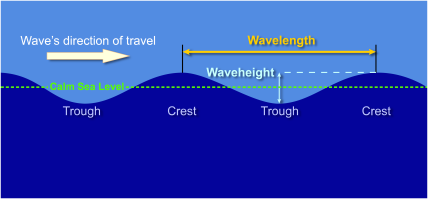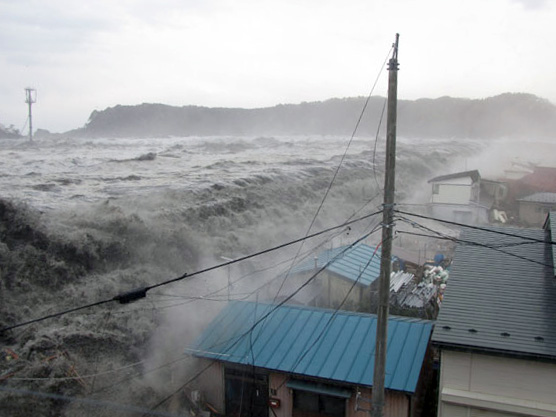Fast Facts
The average depth of the ocean is 2.3 miles (3,700 meters). At almost seven miles (11,000 meters) deep, the "Challenger Deep" in the western Pacific Ocean in the southern end of the Mariana trench is the deepest part of the ocean.
It is common to think of waves as moving water. In deep water, waves are more flowing energy than moving mass. However, when waves approach the coast, they change from moving energy to a mass of moving water.
Fast Facts
The average depth of the ocean is 2.3 miles (3,700 meters). At almost seven miles (11,000 meters) deep, the "Challenger Deep" in the western Pacific Ocean in the southern end of the Mariana trench is the deepest part of the ocean.
It is common to think of waves as moving water. In deep water, waves are more flowing energy than moving mass. However, when waves approach the coast, they change from moving energy to a mass of moving water.
To understand tsunamis, it is helpful to understand how they are different from the familiar ocean waves one might see when standing on a beach. Even though tsunamis and other ocean waves have the same basic anatomy, they are really quite different.

One key difference is that tsunamis move through the entire water column - the full depth of the ocean from the ocean surface to the ocean floor - while other ocean waves only affect the near-surface layer of the ocean. This is because of how they are generated.
Waves are caused by the transfer of energy from their source to the ocean. Most other ocean waves are caused by wind blowing over the water (wind waves). Tsunamis, however, are generated by large and sudden displacements of the ocean, usually caused by an earthquake below or near the ocean floor. These sources can generate more energy than the wind.
Differences between tsunamis and wind-driven waves
| Tsunami | Wind Wave | |
|---|---|---|
| Source | Earthquakes, landslides, volcanic activity, meteorites, certain types of weather | Winds that blow across the near-surface layer of the ocean |
| Location of Energy |
Entire water column, from the ocean surface to the ocean floor | Ocean surface |
| Wave- length |
300-600 miles (500-1,000 kilometers) | 300-600 feet (90-180 meters) |
| Wave Period |
5 minutes-2 hours | 5-20 seconds |
| Wave Speed |
Deep water: 500-600 mph (800-1,000 km/h) Near shore: 20-30 mph (30-50 km/h) |
5-60 mph (8-100 km/h) |
Waves are typically described based on three basic characteristics: wavelength (horizontal distance between wave crests), period (time between wave crests), and speed. Additional differences between tsunamis and wind waves can be seen by examining these characteristics for the two types of waves.
Wind waves have short wavelengths, which are measured in feet, and they can be seen arriving at the shore every few seconds. In contrast, tsunamis have very long wavelengths that are measured in miles, and individual waves arrive minutes to hours apart. Tsunamis are also faster than wind waves.

The longer the wave, the greater the volume of water involved. Though they appear smaller in height (distance between trough and crest) in the deep ocean than some wind waves, tsunamis can grow to much greater heights and cause much more destruction than wind waves at the coast.
As waves enter shallow water near land, they slow down, their wavelength decreases, and their height and steepness (height divided by wavelength) increase.
Because wind waves have shorter wavelengths, their steepness tends to cause them to break at the shore in the typical curling wave. With their energy spent, wind waves then quickly recede.
But the energy in a tsunami is not readily spent and tsunamis do not typically curl and break like wind waves. To break, a wave needs to be very steep.
Because of their long wavelengths, tsunamis do not tend to reach the steepness required to break.
It is because of these long wavelengths, the volume of water they carry, and the amount energy they transmit that tsunamis are so dangerous. Instead of breaking on the shore and quickly receding, a tsunami is more likely to rush onto land like a fast-rising flood and inundate low-lying areas before returning back to the ocean.
Video file
Fast Facts
The average depth of the ocean is 2.3 miles (3,700 meters). At almost seven miles (11,000 meters) deep, the "Challenger Deep" in the western Pacific Ocean in the southern end of the Mariana trench is the deepest part of the ocean.
It is common to think of waves as moving water. In deep water, waves are more flowing energy than moving mass. However, when waves approach the coast, they change from moving energy to a mass of moving water.


